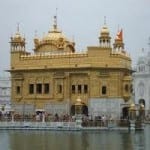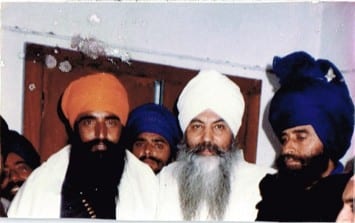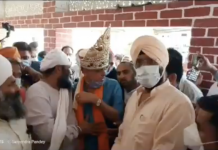The delivery of pre-partition promises by Congress leadership, was the only Sikh political objective up to June 1984. At no time was there any Sikh threat to India’s integrity as a country.



In the aftermath of papers revealed under 30 years rule, what needs to come out with reference to official communications, including Cabinet discussions (e.g. in November 1984), is the British Government’s policy towards the Sikhs as a UK minority, and towards the Indian Government, before, and after, the Indian army siege of Punjab, including the invasion of Darbar Sahib, about 40 other historical Sikh shrines in June, as well as the massacre of Sikhs in November 1984 organized in Delhi, and throughout India.
A key passage in the Anandpur Sahib Resolution reads: “…thus bringing main contiguous Sikh population, and Sikh habitats, with this autonomous Sikh region as an integral part of the Union of India, and, thirdly, this Sikh autonomous region may be declared as entitled to frame its own internal constitutions on the basis of having all powers to, and for, itself except Foreign Relations, Defense, Currency, and General Communications which will remain subjects within the jurisdiction of the Federal Indian Government.” (Anandpur Sahib Resolution)
In the current debate, British, and Indian politicians, and even some Sikhs, forget that the Sikh leaders, including Baba Jarnail Singh Bhindranwale were in Darbar Sahib following Ardaas (supplication) before Sri Akal Takht Sahib to negotiate geographical interpretation of Sikh political rights, and aspirations on the basis of the Anandpur Sahib Resolution.



Norman Kreisman
Yet, after operation Blue Star, Indian PM Indira Gandhi wrote to British PM Margaret Thatcher, “Their objective was secession, and disrupting the unity of the country. The paramilitary forces were insufficient in number to control growing terrorist activities. So we had to send in the army.” British PM’s response was not an expression of regret, or sympathy for the thousands killed on a sacred day for the Sikhs, but sympathy for the Indian PM who decided on a frontal attack on Darbar Sahib (perhaps, against British advice). Indira Gandhi opted for a final military solution as an answer to a just democratic political challenge from the Sikhs.
Sacrifices made during the Indian freedom movement for India’s independence from colonial rule were over 80% Sikh. Congress leaders had made unequivocal promises to the Sikhs as a distinct people in independent India. These promises were not kept.
The Anandpur Sahib Resolution is a reminder on record, of those promises.
Within a few weeks of each other, in February, and March 1984, two UK public servants were giving opposite advice to the Prime Minister Indira Gandhi, and the President of India Giani Zail Singh respectively. One was on official business giving SAS type military advice about invading Darbar Sahib. The other, a visible identity Sikh, on holiday visiting parents, and family, and like some other diaspora Sikhs, expressed grave concern about the build up of the army around Darbar Sahib. (Giani Zail Singh expressed a strong desire to visit UK, if an official invitation could be arranged. Could he not have done that through Indian diplomatic channels? He seemed isolated, preferring to walk in the garden when talking to visitors.)
Few seem to understand the historical theo-political national status of Darbar Sahib in the Sikh psyche. Over the centuries, it is the place where the Sikhs have always gathered to make political decisions. Sikhs have made huge sacrifices to be able to do that.
After over 200 years of Anglo-Sikh relations, with the historical background of early Anglo-Sikh treaties, and wars followed by friendship, through battles like Saragarhi, and the role of the Sikhs in the two World Wars, the ignorance shown about Sikhs by British policy makers is mind bogglingly cruel. The Sikh image, and their identity as a people, continues to suffer due to the ignorance of security profiling in the West.
This is as a direct result of British policy towards the Sikhs (now being expose) before, and after, the invasion of Darbar Sahib.
Despite the House of Lords decision in the Mandla case (1983), Sikhs continue to be denied monitoring in own right as a distinct theo-national community for equal opportunities, and delivery of services in diverse fields. The mainstream media shows remarkable ignorance about Sikh religion, history, and identity. The most visible, and largest, minority community in the UK is made invisible by statistics, and TV cameras! Visible identity Sikhs are missing from the House of Commons. Is it their fault, or that of the political environment, and selection process?
In the aftermath of the exposure of British Government involvement in 1984 events, in addition to public and international inquiries to establish the truth about 1984 Sikh genocide, the need is to redefine meaningful, and genuine Sikh/Government dialogue.





That’s a fascinating photo, taken by an American “white Sikh,” But the photo raises the question what a manipulative hustler like Yogi Bhajan was doing in the midst of these two sants in the time leading up to the attack on Darbar Sahib.
It appears that even Sants aren’t adverse to good old PR. The courting of YB during his India trips had more to do with people’s perception of his wealth than his holiness.
That’s my photo of “The Three Sants” you used in your article. Taken in my room at Guru NanaK Niwas in December 1983 or January 1984. You could (should) have given proper credit to your source.